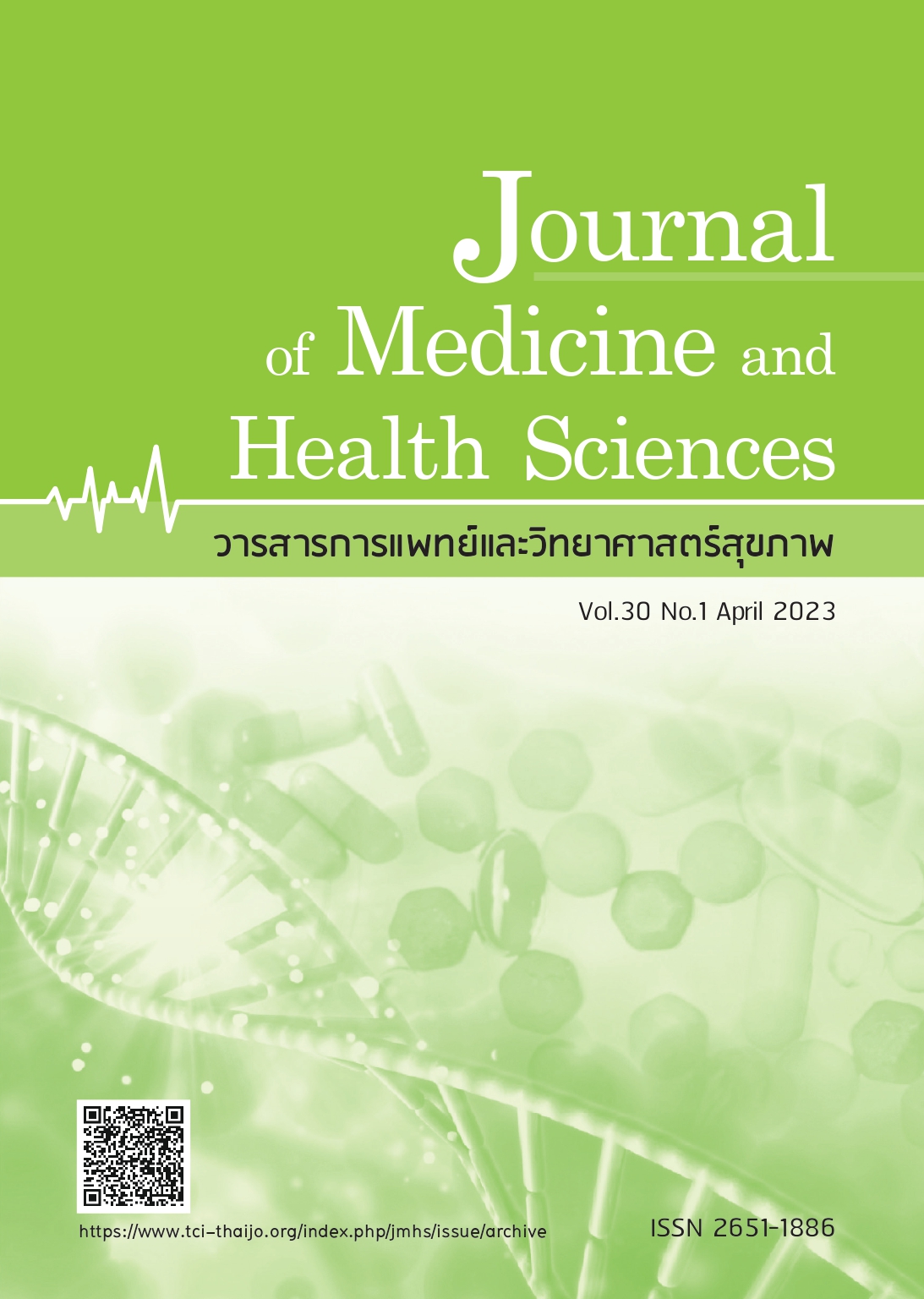การวัดปริมาณรังสีที่รังสีแพทย์ได้รับจากการทำหัตการด้วยการให้ยาเคมีบำบัด ทางหลอดเลือดแดงในการรักษามะเร็งตับ (TACE) ด้วยอุปกรณ์วัดปริมาณรังสีชนิดโอเอสแอล
คำสำคัญ:
การให้ยาเคมีบำบัดทางหลอดเลือดแดง, ปริมาณรังสีจากการทำงาน, อุปกรณ์วัดปริมาณรังสี โอเอสแอลบทคัดย่อ
การทราบค่าปริมาณรังสีที่รังสีแพทย์ได้รับขณะทำหัตถการด้วยการให้ยาเคมีบำบัดทางหลอดเลือดแดง ในการรักษาผู้ป่วยมะเร็งตับ (TACE) จะช่วยเป็นแนวทางในการป้องกันความเสี่ยงของแพทย์ในอนาคต การศึกษานี้ มีวัตถุประสงค์เพื่อตรวจวัดปริมาณรังสีที่เลนส์ตา ไทรอยด์ และมือของรังสีแพทย์ขณะทำหัตถการ TACE และ เพื่อประเมินความเสี่ยงและศึกษาปัจจัยที่ส่งต่อปริมาณรังสีที่แพทย์ได้รับขณะทำหัตถการ TACE อาสามัครเป็น รังสีแพทย์ 2 คน เก็บข้อมูลจากการทำหัตถการ TACE ในผู้ป่วย 16 คน โดยอุปกรณ์วัดปริมาณรังสีโอเอสแอล ชนิดนาโนดอทจะถูกนำไปติดที่กึ่งกลางด้านนอกของอุปกรณ์ป้องกันรังสีที่ไทรอยด์ ด้านนอกแว่นตาตะกั่วทั้งสองข้าง และที่ข้อมือทั้งสองข้างของรังสีแพทย์ เพื่อวัดปริมาณรังสีที่รังสีแพทย์ได้รับจากการทำหัตถการ TACE ผลการศึกษา พบว่าเวลาเฉลี่ยที่ใช้ในการทำหัตถการเท่ากับ 70.8 นาที เวลาเฉลี่ยของการใช้เอกซเรย์ฟลูออโรสโคปีเท่ากับ 19.1 นาที กรณีที่ไม่ใช้อุปกรณ์ป้องกันรังสี รังสีแพทย์ได้รับปริมาณรังสีเฉลี่ยที่ต่อมไทรอยด์ ตาซ้าย ตาขวา มือซ้าย และ มือขวาเท่ากับ 21.8, 56.1, 6.4, 99.5 และ 15.6 µSv ตามลำดับ จำนวนหัตถการสูงสุดที่สามารถทำได้ 29 ราย ต่อเดือน ขณะที่การใช้อุปกรณ์ป้องกันรังสีจะช่วยลดปริมาณเฉลี่ยที่ต่อมไทรอยด์ ตาซ้าย และตาขวา ได้เท่ากับ 4.1, 13.1 และ 1.2 µSv ตามลำดับ และสามารถทำหัตถการได้สูงสุด 128 รายต่อเดือน สรุปค่าปริมาณรังสีที่ รังสีแพทย์ได้รับขณะทำหัตถการ TACE อยู่ในปริมาณที่ปลอดภัยภายใต้ขีดจำกัดการได้รับรังสี การใช้อุปกรณ์ ป้องกันรังสีมีความสำคัญและจำเป็นต่อการช่วยลดอันตรายจากรังสี ผู้ปฏิบัติงานทางรังสีควรหลีกเลี่ยงการได้รับรังสี เมื่อใช้เทคนิคที่ให้ค่าปริมาณรังสีที่สูง
References
Seals KF, Lee EW, Cagnon CH, et al.
Radiation-induced cataractogenesis: A
critical literature review for the Interventional
Radiologist. Cardiovasc Intervent Radiol
;39:151-60.
Stewart FA, Akleyev AV, Hauer-Jensen M,
et al. ICRP publication 118: ICRP statement
on tissue reactions and early and late
effects of radiation in normal tissues and
organs--threshold doses for tissue reactions
in a radiation protection context. Ann ICRP
;41:1-322.
Ferlay J EM, Lam F, Colombet M, et al.
Global cancer observatory: Cancer today:
Lyon, France: International Agency for
Research on Cancer.; 2020 [cited 2021
October 31]. Available from: https://gco.
iarc.fr/today/data/factsheets/populations/
-thailand-fact-sheets.pdf.
Chida K, Kaga Y, Haga Y, et al. Occupational
dose in interventional radiology procedures.
Am J Roentgenol 2013;200:138-41.
Whitby M, Martin CJ. A study of the
distribution of dose across the hands of
interventional radiologists and cardiologists.
Br J Radiol 2005;78:219-29.
Hidajat N, Wust P, Felix R, et al. Radiation
exposure to patient and staff in hepatic
chemoembolization: risk estimation of
cancer and deterministic effects. Cardiovasc
Intervent Radiol 2006;29:791-6.
Martin CJ. A review of radiology staff doses
and dose monitoring requirements. Radiat
Prot Dosimetry 2009;136:140-57.
Chida K, Kato M, Kagaya Y, et al. Radiation
dose and radiation protection for patients
and physicians during interventional
procedure. J Radiat Res 2010;51:97-105.
Sanchez RM, Vano E, Fernandez JM, et al.
Measurements of eye lens doses in
interventional cardiology using OSL and
electronic dosemeters†. Radiat Prot
Dosimetry 2014;162:569-76.
Krisanachinda A, Srimahachota S,
Matsubara K. The current status of eye
lens dose measurement in interventional
cardiology personnel in Thailand. Radiol
Phys Technol 2017;10:142-7.
Landauer. nanoDot™ Dosimeter: Patient
monitoring solutions [cited 2021 October 31].
Available from: https://www.landauer.
com/product/nanodot.
Hamann E, Koenig T, Zuber M, et al.
Performance of a medipix3RX spectroscopic
pixel detector with a high resistivity
gallium arsenide sensor. IEEE Trans Med
Imaging 2015;34:707.
Dolly S. NISTX Calculator: Solutio in silico;
[cited 2020 November 15]. Available
from: http://solutioinsilico.com/medicalphysics/applications/nist-lookup.
php?ans=0.
Funama Y, Nagasue N, Awai K, et al.
Radiation exposure of operator performing
interventional procedures using a flat
panel angiography system: Evaluation
with photoluminescence glass dosimeters.
Jpn J Radiol 2010;28:423-9.
Degiorgio S, Gerasia R, Liotta F, et al.
Radiation doses to operators in
hepatobiliary interventional procedures.
Cardiovasc Intervent Radiol 2018;41:772-80.
Shah P, Khanna R, Kapoor A, et al. Efficacy
of RADPAD protection drape in reducing
radiation exposure in the catheterization
laboratory—First Indian study. Indian
Heart Journal 2018;70:S265-S8.
Palácio EP, Ribeiro AA, Gavassi BM, et al.
Exposure of the surgical team to ionizing
radiation during orthopedic surgical
procedures. Rev Bras Ortop 2014;49:227-32.
Wilson-Stewart KS, Fontanarosa D, Li D,
et at.Taller staff occupationally exposed
to less radiation to the temple in cardiac
procedures, but risk higher doses during
vascular cases. Scientific Reports 2020;10:
Mechlenburg I, Daugaard H, Soballe K.
Radiation exposure to the orthopaedic
surgeon during periacetabular osteotomy.
Int Orthop 2009;33:1747-51.
Boddu SR, Corey A, Peterson R, et al.
Fluoroscopic-guided lumbar puncture:
fluoroscopic time and implications of
body mass index--a baseline study. Am J
Neuroradiol 2014;35:1475-80.
Kim HO, Lee BC, Park C, et al. Occupational
dose and associated factors during
transarterial chemoembolization of
hepatocellular carcinoma using real-time
dosimetry: A simple way to reduce
radiation exposure. Medicine (Baltimore)
;101:e28744.
Downloads
เผยแพร่แล้ว
How to Cite
ฉบับ
บท
License

This work is licensed under a Creative Commons Attribution-NonCommercial-NoDerivatives 4.0 International License.





